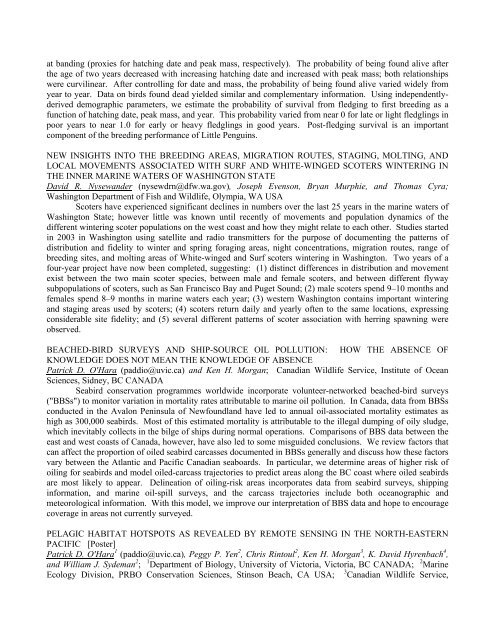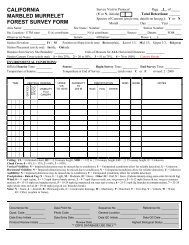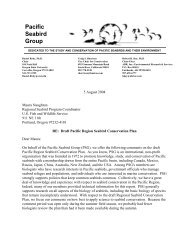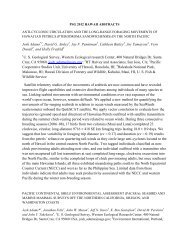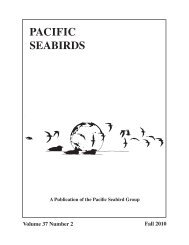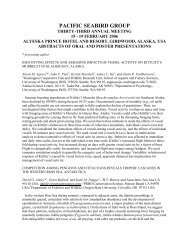abstracts of oral and poster presentations - Pacific Seabird Group
abstracts of oral and poster presentations - Pacific Seabird Group
abstracts of oral and poster presentations - Pacific Seabird Group
Create successful ePaper yourself
Turn your PDF publications into a flip-book with our unique Google optimized e-Paper software.
at b<strong>and</strong>ing (proxies for hatching date <strong>and</strong> peak mass, respectively). The probability <strong>of</strong> being found alive after<br />
the age <strong>of</strong> two years decreased with increasing hatching date <strong>and</strong> increased with peak mass; both relationships<br />
were curvilinear. After controlling for date <strong>and</strong> mass, the probability <strong>of</strong> being found alive varied widely from<br />
year to year. Data on birds found dead yielded similar <strong>and</strong> complementary information. Using independentlyderived<br />
demographic parameters, we estimate the probability <strong>of</strong> survival from fledging to first breeding as a<br />
function <strong>of</strong> hatching date, peak mass, <strong>and</strong> year. This probability varied from near 0 for late or light fledglings in<br />
poor years to near 1.0 for early or heavy fledglings in good years. Post-fledging survival is an important<br />
component <strong>of</strong> the breeding performance <strong>of</strong> Little Penguins.<br />
NEW INSIGHTS INTO THE BREEDING AREAS, MIGRATION ROUTES, STAGING, MOLTING, AND<br />
LOCAL MOVEMENTS ASSOCIATED WITH SURF AND WHITE-WINGED SCOTERS WINTERING IN<br />
THE INNER MARINE WATERS OF WASHINGTON STATE<br />
David R. Nysew<strong>and</strong>er (nysewdrn@dfw.wa.gov), Joseph Evenson, Bryan Murphie, <strong>and</strong> Thomas Cyra;<br />
Washington Department <strong>of</strong> Fish <strong>and</strong> Wildlife, Olympia, WA USA<br />
Scoters have experienced significant declines in numbers over the last 25 years in the marine waters <strong>of</strong><br />
Washington State; however little was known until recently <strong>of</strong> movements <strong>and</strong> population dynamics <strong>of</strong> the<br />
different wintering scoter populations on the west coast <strong>and</strong> how they might relate to each other. Studies started<br />
in 2003 in Washington using satellite <strong>and</strong> radio transmitters for the purpose <strong>of</strong> documenting the patterns <strong>of</strong><br />
distribution <strong>and</strong> fidelity to winter <strong>and</strong> spring foraging areas, night concentrations, migration routes, range <strong>of</strong><br />
breeding sites, <strong>and</strong> molting areas <strong>of</strong> White-winged <strong>and</strong> Surf scoters wintering in Washington. Two years <strong>of</strong> a<br />
four-year project have now been completed, suggesting: (1) distinct differences in distribution <strong>and</strong> movement<br />
exist between the two main scoter species, between male <strong>and</strong> female scoters, <strong>and</strong> between different flyway<br />
subpopulations <strong>of</strong> scoters, such as San Francisco Bay <strong>and</strong> Puget Sound; (2) male scoters spend 9–10 months <strong>and</strong><br />
females spend 8–9 months in marine waters each year; (3) western Washington contains important wintering<br />
<strong>and</strong> staging areas used by scoters; (4) scoters return daily <strong>and</strong> yearly <strong>of</strong>ten to the same locations, expressing<br />
considerable site fidelity; <strong>and</strong> (5) several different patterns <strong>of</strong> scoter association with herring spawning were<br />
observed.<br />
BEACHED-BIRD SURVEYS AND SHIP-SOURCE OIL POLLUTION: HOW THE ABSENCE OF<br />
KNOWLEDGE DOES NOT MEAN THE KNOWLEDGE OF ABSENCE<br />
Patrick D. O'Hara (paddio@uvic.ca) <strong>and</strong> Ken H. Morgan; Canadian Wildlife Service, Institute <strong>of</strong> Ocean<br />
Sciences, Sidney, BC CANADA<br />
<strong>Seabird</strong> conservation programmes worldwide incorporate volunteer-networked beached-bird surveys<br />
("BBSs") to monitor variation in mortality rates attributable to marine oil pollution. In Canada, data from BBSs<br />
conducted in the Avalon Peninsula <strong>of</strong> Newfoundl<strong>and</strong> have led to annual oil-associated mortality estimates as<br />
high as 300,000 seabirds. Most <strong>of</strong> this estimated mortality is attributable to the illegal dumping <strong>of</strong> oily sludge,<br />
which inevitably collects in the bilge <strong>of</strong> ships during normal operations. Comparisons <strong>of</strong> BBS data between the<br />
east <strong>and</strong> west coasts <strong>of</strong> Canada, however, have also led to some misguided conclusions. We review factors that<br />
can affect the proportion <strong>of</strong> oiled seabird carcasses documented in BBSs generally <strong>and</strong> discuss how these factors<br />
vary between the Atlantic <strong>and</strong> <strong>Pacific</strong> Canadian seaboards. In particular, we determine areas <strong>of</strong> higher risk <strong>of</strong><br />
oiling for seabirds <strong>and</strong> model oiled-carcass trajectories to predict areas along the BC coast where oiled seabirds<br />
are most likely to appear. Delineation <strong>of</strong> oiling-risk areas incorporates data from seabird surveys, shipping<br />
information, <strong>and</strong> marine oil-spill surveys, <strong>and</strong> the carcass trajectories include both oceanographic <strong>and</strong><br />
meteorological information. With this model, we improve our interpretation <strong>of</strong> BBS data <strong>and</strong> hope to encourage<br />
coverage in areas not currently surveyed.<br />
PELAGIC HABITAT HOTSPOTS AS REVEALED BY REMOTE SENSING IN THE NORTH-EASTERN<br />
PACIFIC [Poster]<br />
Patrick D. O'Hara 1 (paddio@uvic.ca), Peggy P. Yen 2 , Chris Rintoul 2 , Ken H. Morgan 3 , K. David Hyrenbach 4 ,<br />
<strong>and</strong> William J. Sydeman 2 ; 1 Department <strong>of</strong> Biology, University <strong>of</strong> Victoria, Victoria, BC CANADA; 2 Marine<br />
Ecology Division, PRBO Conservation Sciences, Stinson Beach, CA USA; 3 Canadian Wildlife Service,


